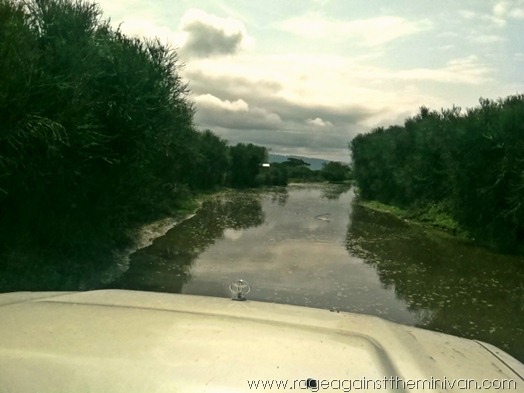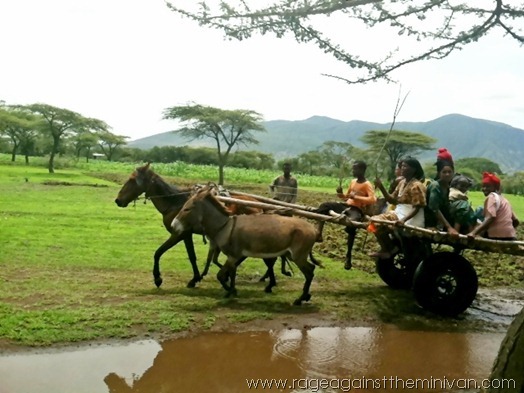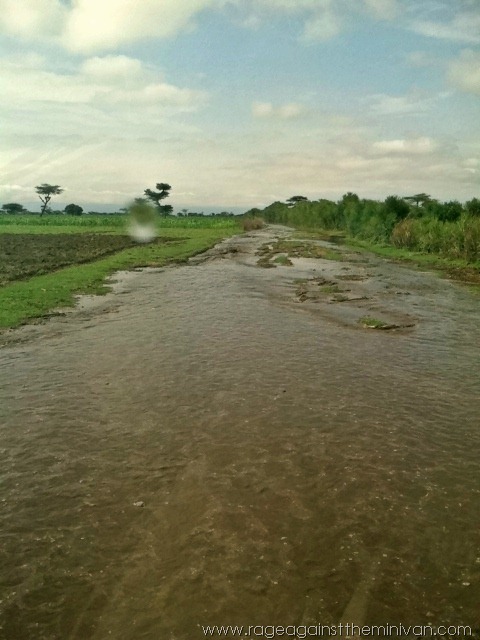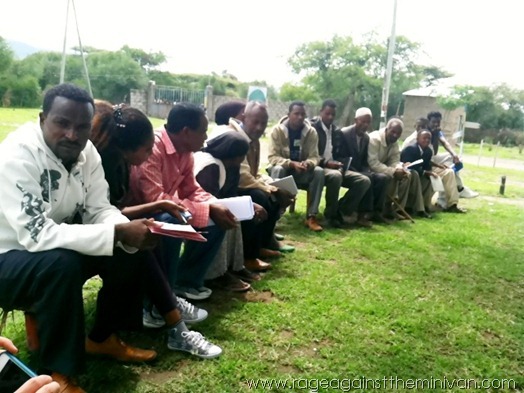One of Food for the Hungry’s mission statements is "”we go to the hard places.” I guess they wanted us to see this first-hand today. We had a meeting with some community leaders in a nearby village, and we had to take a river to get there.  A river cruise in a Toyota.
A river cruise in a Toyota.  There was about 9 miles of road that looked like this . . . one big river. It was so deep that there were a number of times I was sure the car would just start floating. I took my seatbelt off at one point, to prepare myself to swim. Fortunately, that didn’t happen.
There was about 9 miles of road that looked like this . . . one big river. It was so deep that there were a number of times I was sure the car would just start floating. I took my seatbelt off at one point, to prepare myself to swim. Fortunately, that didn’t happen.  We were the only car braving this road, but every so often we would pass a donkey cart. They seemed to fare better than the Toyota.
We were the only car braving this road, but every so often we would pass a donkey cart. They seemed to fare better than the Toyota.  I’m pretty sure these people were laughing at the Americans taking a car down the river.
I’m pretty sure these people were laughing at the Americans taking a car down the river.  Nine miles of this. But I didn’t mind . . . it was a beautiful drive.
Nine miles of this. But I didn’t mind . . . it was a beautiful drive. 
 A lot of children ran out from their villages to shout at us. I’m not sure what they were saying, but I’m guessing it was somethig along the lines of “ya’ll are so stupid”.
A lot of children ran out from their villages to shout at us. I’m not sure what they were saying, but I’m guessing it was somethig along the lines of “ya’ll are so stupid”. At one point during the journey, after a particularly scary pass, one of the Ethiopian locals pointed out a group of gravestones. He was just being helpful but we were all cracking up at the timing.
At one point during the journey, after a particularly scary pass, one of the Ethiopian locals pointed out a group of gravestones. He was just being helpful but we were all cracking up at the timing. 
After our wild ride, we arrive at Oitu, a remote village at the foot of an inactive volcano. This village is considered “food insecure”, because the soil cannot sustain enough agriculture to feed the community. The people here struggle to survive, and Food for the Hungry has only been in the community for three months. One of the aspects I love most about Food for the Hungry is that they are very reliant on local leadership, for both planning and implementation. The rely on locals to identify children in need, and also to give input as to what specific developments would be most helpful to the community. We had a chance to participate in the meeting with the community leaders identified in Oitu. Some were teachers, some were social workers employed by FH, and some were farmers. This village is considered “food insecure”. Many people are working very hard at farming but the soil is poor, and rain can be temperamental. It is estimated that this year, 300 people in Oitu may e at risk of losing their life due to lack of food. Child sponsorship will make a huge impact on this community.  I loved the spirit of this meeting. There were no powerpoint presentations, no laptops, and no power suits. It was a humble group of adults in ill-fitted clothing, sitting on a wooden slat bench. And yet, these people had so much wisdom and compassion for their community. If only American politics worked this way. I love that this organization is not about coming in and telling the community how to do things, but rather listening to local community leaders and have them consult in all decision-making. (I will talk more on this later, but it is worth noting that thus far, at every level it is native Ethiopians who are in leadership at FH.)
I loved the spirit of this meeting. There were no powerpoint presentations, no laptops, and no power suits. It was a humble group of adults in ill-fitted clothing, sitting on a wooden slat bench. And yet, these people had so much wisdom and compassion for their community. If only American politics worked this way. I love that this organization is not about coming in and telling the community how to do things, but rather listening to local community leaders and have them consult in all decision-making. (I will talk more on this later, but it is worth noting that thus far, at every level it is native Ethiopians who are in leadership at FH.) One of the questions we asked the leaders was: How has food for the hungry impacted your community? Here are a few of their answers:
One of the questions we asked the leaders was: How has food for the hungry impacted your community? Here are a few of their answers:
“Since FH started 3 months ago, things with the children have improved, especially clothing, hygiene, and education. We hope in the future the org will improve a lot. The relation with the children is very good.” “The time is very short but initially there are 350 children, now about 500 children in the program, they have started working with the children and established their own office and playground, and this indicates they are on the path for the future.”
Another question we asked: What are some of the challenges you face as a community?
“Major crops are maize, sourgum, and beans. It only harvests once per year. If it fails, the community will suffer because it only happens once per year.” “The community doesn’t have a health center, so when people get sick, it is difficult to take them to Bulbula because it is far and the roads are poor.” “School is overcrowded, textbooks are scarce, after 8th grade, children have to go to school in another town and pay to live with someone else.” “The area is malaria prone. The health center is not fully functioning and we are dependent on rain for clean drinking water.” “Because of low crop production, incomes are low. Because of that parents cannot afford school materials so there are many children out of school. Because of the low income there is no office for the women’s association. Kids need a local high school.” “The school looks nice from the outside but inside many things are not finished. There is no library and the rooms are too small for the children. CHildren do not have sports materials.”
These are some of the community issues that Food for the Hungry will help address with child sponsorships. I also asked the leaders what they would say to Americans who are considering child sponsorship. I’ll let you hear it from them. If you are interested in learning more about child sponsorship. click here. 
